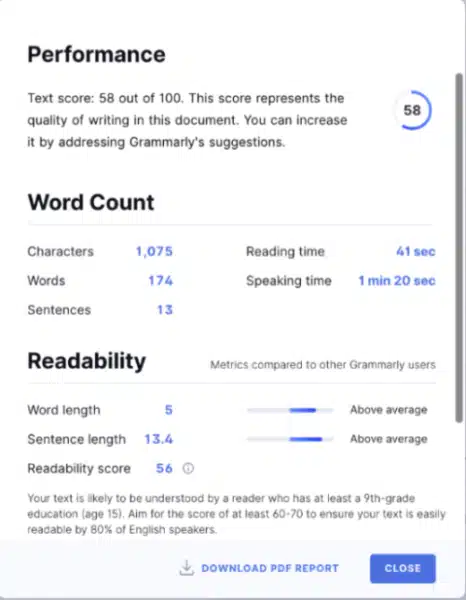
How is your website content performing? What about the blog content you posted two months ago? Two years ago?
Does all of this help you achieve your goals? Do you know or have no idea?
Then it’s time for a content audit.
What is a content audit? Why should you make one?
A content audit is a systematic review of your site’s content, including:
Blogs. Landing pages. Product or service pages. Basic content pages.
This review helps you understand if your content is working to achieve your goals, including reaching your intended audience.
But that’s not all it does.
4 benefits of doing a content audit
1. Shows you what content needs improvement (backed by data)
In addition to showing you whether your content is working overall, a content audit also gives you specific direction on areas you need to improve.
For example, you may find broken links you weren’t previously aware of, missed keyword opportunities, missing metadata, and other issues you can easily fix to improve content usability and search visibility.
2. It gives you a bird’s eye view of your content as a whole
If you have a lot of content on your website, an audit can be a colossal undertaking. However, completing a content audit is the only way to explore all of your content and gain a true understanding of whether it’s serving your business…or not.
3. A content audit helps you optimize your content for performance
Even if you have a very small business with little content, a content audit is still useful. It will help you optimize the content you have to perform at its best.
And content that works is powerful.
It can convince potential customers that your brand is trustworthy: 64% of consumers said they believe a brand is trustworthy after reading educational content from that brand. (driver)
Good content can influence purchase decisions: Consumers were 131% more likely to buy from a brand with effective content. (Driver) Optimized content is a lead machine: it brings 3x the leads of traditional marketing, but costs 62% less to maintain. (Demand metric)
4. It will improve your future content creation
Because a content audit helps you understand what’s working and what’s not (because you’ll see evidence of both on your site!), you can apply it to your future content creation for better results.
When to do a content audit
Now that you know what a content audit is and why you should do one, the next question is when.
When is the best time to do a content audit?
Consider these scenarios:
Your website is a few years old and you have never done a content audit before. (You’re probably overdue!) You’re creating a content strategy and want a clear picture of what you’re working on. You’re revising your content strategy or redesigning your website.
Basic steps of a content audit
How does a content audit work? Basic steps include setting goals, collecting content and data points, and critically analyzing what you discover.
Step 1: Set goals
Don’t go into a content audit without a clear goal, otherwise you won’t know what types of content or data points to focus on. Find out what you hope to get out of your content audit.
Step 2: Collect, categorize and organize your content
You need a way to compare and contrast your content pieces, get a bird’s-eye view of the data, and categorize each piece based on the action you take.
Step 3: Analyze your content
Look at the data and determine which parts to update, rewrite, keep or delete.
Step 4: Make a plan based on your findings
Make a priority list for the pieces of content that need immediate attention and make a plan for how you will perform updates and rewrites.
Step 6: Adjust your content strategy
What did you learn from your content audit? Bring this into your future content strategy.
Get the daily search newsletter marketers trust.
Tools to use for a content audit
When you’re ready to do your content audit, there are a few options for how you can collect URLs, data, and metrics and bring it all together for optimal analysis.
Here are some of the tools you may need.
1. A plain old spreadsheet
For a no-frills content audit, or for a relatively small site, a simple spreadsheet is a good choice.
A spreadsheet will help you distribute the information and data in your content in an organized way that will make it easier for you to analyze.

This is the cheapest way to do a content audit because you don’t need any special tools besides Microsoft Excel or Google Sheets.
Cons: It can be very time-consuming to collect all your data manually, especially if you have more than a few dozen pieces of content to audit.
2. Analysis software
Analytics data is important to your content audit. This includes metrics such as pageviews, number of internal links and backlinks, bounce rate, time on page, conversion rate, average position in Google and many more.
You need concrete data about each piece of content so you can decide what action to take next (update, rewrite, delete, or keep as is).
If you’re not already tracking the performance of your content in a tool like Google Analytics, you can pull your different metrics from SEO tools like Semrush, Ahrefs, or SEO Site Checkup.
3. Content quality tools
To help you quantify the quality of your content, you may want to use some of these tools to check your content for readability, grammar, word usage, and reading level.
Yoast SEO: This tool analyzes your text and provides scores and suggestions to improve readability.

grammatically: In addition to checking grammar and spelling, it offers the paid version of Grammarly performance score that may be useful to include in a content audit.

4. A content inventory tool
If you have a large site, you may need to invest in a content inventory tool to make your life easier. These tools use the sitemap to automatically grab content URLs and associated metrics.
Some good options are Screaming Frog SEO Spider and Semrush’s Content Audit Tool.
Types of content audits and their associated objectives
While you can certainly audit every piece of content on your site, it’s best to narrow your focus and complete an audit based on content type and goals.
For example, audit all your blog content, all landing pages, all product/service pages, or all main content pages.
After choosing a content type, decide what goal you want to achieve with your content audit. Here are some of the common ones:
1. Goal: SEO
When you approach a content audit with the goal of improving your SEO, you’ll be concerned about how your content is performing on Google. You will need to ask yourself if your content is properly optimized for search engines i search engines. Look at:
Content quality. word count Keyword difficulty and search volume. Google average position. Organic Pageviews. Content structure and keyword optimization. (Are there keyword headers? How is the piece organized? Is the focus keyword optimally placed?)
2. Goal: better engagement and usability
In order to improve engagement and usability, your content audit should focus on how your readers interact with your content and how to increase that engagement. Look at:
Social actions. Time on Page Bounce percentage. Conversions. Internal links and/or broken links.
Specifically, see which pieces gain the most or least engagement and analyze what contributes to that success or failure.
3. Objective: Optimizing conversions
Another goal you can pursue with a content audit is to look at how your content is converting and find out what needs to be improved. You can watch:
How well your content addresses each stage of the buyer’s journey and if there are gapsWhich pages are converting successfully and which are not, comparing metrics such as: Time on page.Bounce rate.Conversion rate.
What is a content audit? Answer: A necessary part of your content strategy
A content audit is, quite simply, the only way to understand your content on a few different levels: down in the weeds and from a bird’s eye view.
Whether your site is large or small, a content audit can help you understand what you have, what you need, what you don’t need, and what actions you can take going forward to ensure your content ecosystem is contributing to your goals .
Remember: there is no perfect or set way to conduct a content audit. Your audit may change depending on the type of content you are analyzing and the goals you hope to achieve by completing the audit. With this in mind, adjust your content audit to suit what your site and content strategy calls for.
Finally, don’t forget to do regular content audits. One and done will only help your site/business for a limited time. As your content grows, you need to keep taking snapshots of how it’s performing, continually tweaking and course-correcting.
Content audits are integral to a well-oiled content strategy; do not neglect this task and you will see results.
The opinions expressed in this article are those of the guest author and not necessarily Search Engine Land. Staff authors are listed here.
New in Search Engine Land
About the author

Julia McCoy is the founder of Content Hacker, a 7x author, and a leading strategist for creating exceptional content and brand presence that lasts online. At 19, he used his last $75 to build a 7-figure writing agency that he sold ten years later. In the 2020s, he’s dedicated to teaching founders and marketers the strategy, skills, and systems they need to build a business through inbound content, so they can create a more lasting impact on the world.
[ad_2]
Source link




